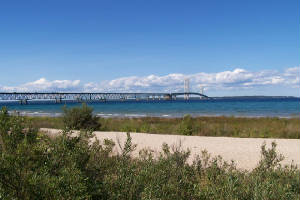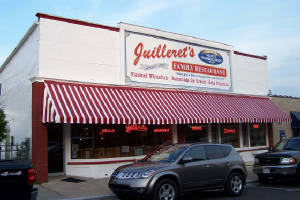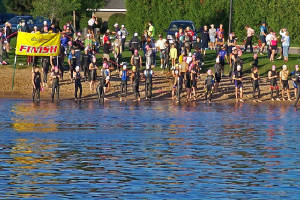|
|
 |
|
|
 |
August 16 Mackinaw City to St. James Harbor, Beaver Island
43.2 miles
When we left the dock at Mackinaw City, we immediately entered the Straits of Mackinaw, where Lake
Michigan and Lake Huron meet each other and merge their waters. It is notorious for rough conditions, as it is churned
by winds and currents where the wide waters of both lakes are pinched into a four mile wide natural channel between them.
Today, we had a fair weather passage.

|
| Mackinaw Bridge |
The five-mile-long Mackinaw Bridge crosses the Straits of Mackinac, connecting Mackinaw City with St. Ignace
in Michigan's Upper Peninsula. When it was built in 1957, it was the longest single-span suspension bridge in the world,
and a great engineering triumph. We learned all about its construction in a little museum in the upper level of a Mackinaw
City Pizza parlor where we ate lunch. Before the bridge was built, the line of cars waiting for the car ferries during
deer hunting season could stretch for fifteen miles!
We arrived at St. James Harbor, at the north end of Beaver Island at 1:30. We dropped our anchor,
ate lunch aboard, then set out with Roxanne and Lenny to explore the village of St. James.
We spent a couple fascinating hours at two well-curated museums operated by the local historical society
-- a maritime museum in a net shet built in 1904, and a local history musuem in a mid-nineteenth century Mormon printship
downtown.
The town and harbor are named for James Jesse Strang, a renegade leader of a Mormon sect who brought his
followers here in 1847, shortly after the founder of the Mormon religion, Joseph Smith, was assassinated. Strang claimed
to find some copper scriptural plates on Beaver Island, similar to the ones Smith had found in New York State. Skeptics
suspected he made the plates himself from an old cooking pot, but for his followers, Strang's translation of the plates and
his visions from God reinforced his leadership of a Mormon kingdom on the Island.
In addition to establishing himself as king of Beaver Island, Strang was a brilliant politician, and got
himself elected state senator twice. He negotiated a rearrangement of Michigan counties so that his kingdom of St. James
replaced Mackinac as the county seat.
All that power eventually went to his head. He started wearing a crimson robe and crown and actively
promoting polygamy. When President Millard Fillmore got wind that Strang was claiming God had given all the Great Lakes
Islands to him, federal agents rounded up Strang and some of his close aides to bring them to trial. They got off with
a hand slap, but many of his followers were disillusioned by this time, and his power base was shaken.
Two of his followers assassinated Strang in 1856 under suspicious circumstances. They escaped to Mackinac
on a government ship, were unconditionally released there, and were never prosecuted.
With Strang out of the way, a posse of Irishmen drove the Mormons from the island and took over all
their holdings. There is still a strong Irish influence on the island, and many of the descendents of the Irish who
drove out the Mormons still live here.
By the mid-1880s, Beaver Island was the largest supplier of fresh-water fish in the country. We are amazed
that every place we visit, no matter how small and unassuming it may seem, has some historical claim to being biggest, oldest,
first, or best at something. And, most have at least one "world famous" restaurant, attraction, or person who was
born there.
Another, more sobering commonality uniting many places we have visited is the exploitation of native people
practiced by European settlers. In this case, we learned about Whiskey Point, where the island lighthouse is now located,
and where, in the early years, traders exchanged watered-down whiskey for furs and other valuable goods from the Ojibway and
Odawa. The recipe for watered-down whiskey called for mixing two gallons common whiskey with thirty gallons water, red
pepper and Tobasco to make it fiery, and tobacco to make it intoxicating. It cost six cents per gallon to make, and
sold for fifty cents per gallon, or six cents per drink.
One of Beaver Island's other claims to fame is that for ninety years, until 1991, it had one of only two
public school systems in the country taught by Dominican Sisters. Today, the school system has nine teachers and 95
students -- the high school class of '05 had four graduates.
August 17 Beaver Island to Harbor Springs, on LittleTraverse Bay
37.3 Miles
We spent nearly five hours cruising in light winds and calm waters to get to Harbor Springs, aptly nicknamed
"Naples of the North." The water was clear turquoise, our boat was dwarfed by many of the other boats at the marina,
the shops in town catered to people who will drop $100 for a tee shirt or twice that for a bathing suit, and the homes around
town were mostly built in the fifty years between 1875 and 1925 when it was a resort for the rich, which it pretty much still
is.
Across from us on the dock was an 80 feet yacht hailing from Palm Beach that passed us on the way to Mackinac
Island a couple days ago. Back then, a uniformed captain was at the helm, a steward in a white tuxedo was consulting
with him, and a couple was dining in their spacious salon. We concluded at the time that even though they were
probably visiting the some of the same ports we were, their cruising experience was worlds away (they probably didn't sneak
into the Grand Hotel to avoid paying the $10 visitor fee, for example).
The people on the 46 foot yacht next to us kept an identical boat in Florida to avoid the inconvenience
of having to move their boat south for the winter, or having to adjust to a different boat when they headed south

|
| Ephraim Shay House |
We pulled our bikes off the boat, and rode along the shore road, admiring the elegant Victorian "cottages,"
and their immaculately maintained gardens. One of the most interesting houses we saw had many sides and was sheathed
in steel plates. It was built for Ephraim Shay, inventor of the Shay locomotive, patented in 1881. The gear-drive
mechanism of the locomotive gave it good traction and ability to make tight curves, a particular asset in mining and
logging operations.
We found a yarn and fiber shop, where I got larger size knitting needles for the scarf project I began
in Gore Bay, and abandoned after one hour of unsuccessfully stabbing around with my little needles. After explaining
my problem and my hopes that bigger needles would aid my knitting the way big pencils help little kids write, I picked up
a helpful tip from the shop owner on how to cast on my stitches so that they would be loose enough for me to push a needle
in to stitch my first row. I am now imagining myself stopping in every knitting shop we see along the way to get
tips on how to get to the next step of my project. Somehow I had forgotten until now that when I got my Girl Scout sewing
badge Mrs. Meyers pretty much held my hands in hers and we stitched the whole swatch for the knitting requirement together.
Why I didn't remember this earlier I can't say. But having new experiences and stretching myself is what this trip is
all about, isn't it?

Harbor Springs is a place Dick has visited often in past summers, and we visited some of his favorite culinary
spots -- we stopped at Tom's Mom's Cookies for an afternoon snack, and had planked whitefish at Juilleret's for dinner.
Juilleret's grills their whitefish on a wooden board, and serves it family style with tomatoes and mashed potatoes
piped around the edges. Juilleret's claims to be "Michigan's Oldest Family Run Restaurant," and has been a Harbor Springs
institution since 1895. Its popularity shows no signs of waning.
August 18-20 Across the Bay to Petoskey
We rocked through the night in wind-driven waves, and woke to 20 mph winds and whitecaps on the bay.
Fortunately, we had only four miles to travel across the bay to Petoskey, where a more sheltered harbor awaited us.
It rained hard for a good chunk of every day we were in Petoskey. But, we agreed that if we had to
be trapped in port for weather, Petoskey was a great place to be stuck. It has lots of interesting shops to browse,
good restaurants , and a top-notch coffee shop next to a bookstore that sells the New York Times.
Our first order of business when we arrived was lunch at Jesperson's, family owned since 1903, and
famous for their pies. This was another mandatory stop on Dick's culinary tour of Northern Michigan, and we all
agreed the pies alone were worth a stop in Petoskey (although we couldn't agree on which was best -- cherry berry or peach
raspberry).
This weekend, Petoskey was celebrating their Festival on the Bay, with an arts and crafts fair, lots of
live music, aa canoe and kayak race, food booths, sunset celebrations, outdoor movies, and other activities planned.
Unfortunately, the weather put a bit of a crimp in the festivities, and some events were rained out, but we had a grand time.
Friday night we walked to Bay View, where we had dinner on the terrace of the historic Terrace Inn, then
attended a jazz concert by the Ellis Marsalis quartet in the Bay View auditorium. Bay View was founded as a religious
camp meeting site in 1875. The auditorium is in a section of Bay View known as the Campus, where Summer Assembly educational
and worship programs have been held throughout the colony's history. Today, there are 440 summer cottages in Bay View,
and it maintains its focus as a spiritual community "dedicated to providing congenial surroundings for those interested in
promoting religion and morality through intellectual and scientific culture." To own a cottage, a person has to
apply for membership in the Bay View Association, providing references from his minister, Bay View members, and others, and
pass a personal interview. Once approved, Association members are expected to be active participants in the classes
and programs offered during Summer Assembly.
Although we didn't see it in writing, it is clear that members are expected to keep their cottages in peak
condition. The cottages range in size from tiny to grand, but peeling paint or broken gingerbread trim are hard to find. There
are lots of painted ladies with outrageous color schemes, and over-the-top fancy trim details -- it is fun to stroll
around the grounds. (We did it on snowshoes last time we were here, and it is even better now, with flowers in bloom,
and shutters open.)
Saturday we began the day with the Rotary Pancake Breakfast, served in a tent on the waterfront right by
the marina. It's good they had a tent, because it was pouring. Unfortunately, the tent was in an area of low ground.
Part of our breakfast entertainment was watching a crew try to dig a trench to divert the water to a spot where they could
pump it away. They were no match for the rain.
After breakfast, we played cards with Lenny and Roxanne while it rained. And rained.
We went to lunch at Jesperson's (Dick couldn't leave Petoskey without another piece of their pie),
then checked out the arts and crafts show.
The local history museum is right near the marina, in an old train station. We learned about Ernest
Hemmingway's connection to Petoskey through a video narrated by his nephew, who still lives in the family cottage on Walloon
Lake where Ernest spent childhood summers and honeymooned with the first of his five wives. Another interesting exhibit
in the museum told of Petoskey's role in the demise of the Passenger Pigeon. This area was a prime nesting ground for
the birds, and during the first week of April 1878, 18,000 pigeons per day were shipped from Petoskey in barrels -- 1.5 million
birds were harvested that season. In 1914, the last Passenger Pigeon died in the Cincinnati Zoo.
Later we watched a juggler on the waterfront, got sausages for dinner from a Festival booth, and ate
them while watching the sunset and listening to the featured live entertainment, Mitch Ryder and the Detroit Wheels.
Music from other artists lasted late into the evening.
August 21-22 Trapped in Petoskey
We got up at 6 a.m. Sunday morning, planning to beat the predicted storms, but they beat us -- high winds
and rough seas kept us in port. We hoped to leave Monday, but the weather hadn't calmed down. We like this town,
but we are ready to leave.

|
| Swimmers gathering for the triathlon start |
Sunday morning, (after we fueled up, pumped out, and went about a quarter mile out in the bay, turned around
and tied up in our slip again), we watched the swimming leg of a triathlon. The start and finish lines were at a beach
between the marina docks and a breakwater, so we had perfect front-row seats. Officials altered the course so
that swimmers did not have to swim too far outside the beakwater, because the wave action in the open water was tossing
the race monitoring and rescue vehicles too much. Even inside the breakwater, the water was pretty choppy, and it was
cold -- Dick's heat gun clocked it at 66 degrees.
About 100 people did the swim, and only three had to be pulled out before the finish line (the first
clue they might not make it was they weren't wearing wetsuits). Forget the rest of the race -- to have just finished
the swimming leg in this weather was an accomplishment to be proud of.
We whiled away our cool and rainy time reading the Sunday New York Times in Roast and Toast, playing cards
with Lenny and Roxanne, and reading. When we hit what we thought was a break in the weather, we hiked off in search
of a couple geocaches, only to get soaked in a cloudburst on our way back to the boat. We hosted Looper cocktails aboard
Starsong with Roxanne and Lenny, plus Stan and Annie from Kokapelli and Elliot from Letitia.
Monday was more of the same bad boating weather, and more of the same shore-bound activities -- hot coffee
and later hot soup at Roast and Toast, reading books and newspapers, catching up on paperwork and bills. We got
a whole cherry berry pie from Jesperson's as a self-awarded consolation prize, and had friends over for cocktails to commiserate.
We did learn about another of Petoskey's unique claims to fame. Sunken in 24 feet of water off the
waterfront beach here is an eleven foot marble crucifix believed to be the only fresh water underwater shrine in the world.
The statue was placed by the local dive club, and is visited by scuba divers in season. In the winter, they dig a hole
in the ice so landlubbers can walk out and look down through the clear water to see the shrine. If we had a day
of calm water, we'd take our dinghy out to see if we could find the shrine, but, obviously, that little exploration will have
to wait for another visit.
The weather is supposed to turn tomorrow. Did I say we are ready to leave?
|
 |
|
|
 |
|
|
 |
|
|
|
|
|
|
 |

